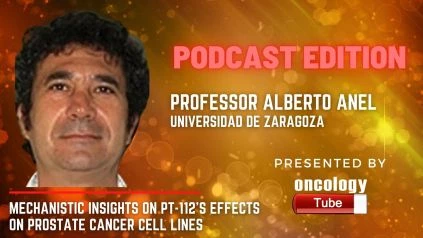Alberto Anel, Ph.D., Professor of Biochemistry, Department of Biochemistry and Molecular and Cellular Biology, Biochemistry and Molecular Biology Area, Science Faculty at the Universidad De Zaragoza. In this video, he speaks about the AACR 2022 Abstract – Mechanistic Insights On PT-112’s Effects On Prostate Cancer Cell Lines.
Â
Overview:
Â
To test PT-112 in a human prostate cancer cell panel for differential sensitivity, cell death mechanism, development of mitochondrial stress, and release of damage-associated molecular patterns (DAMPs).
Â
Origins:
Â
PT-112 is a new pyrophosphate-platinum compound that has shown therapeutic effectiveness in advanced solid cancers such as lung, thymoma, and castration-resistant PC, as well as multiple myeloma. PT-112 cancer cell killing has previously been proven to be independent of DNA damage. PT-112 promotes mitochondrial reactive oxygen species (mtROS) buildup, DAMP release, immunogenic cell death (ICD), and T cell infiltration in both in vitro and in vivo mice tests.
Â
Methodologies:
Â
Human PC cell lines (LNCap, LNCap-C4, LNCap-C4-2, DU-145, 22Rv1, VCap, and PC-3) and the non-tumorigenic prostate cell line RWPE-1 were tested for PT-112 sensitivity. Using flow cytometry, we investigated cell death parameters such as apoptotic and necroptotic indicators, mitochondrial membrane potential, mtROS, and autophagy. We also looked at how PT-112 affected ICD indicators including calreticulin (CRT) cell surface exposure and ATP secretion. Finally, a putative relationship between HIF-1alpha expression and PT-112 sensitivity was looked into.
Â
Outcomes:
Â
PT-112 inhibited growth and caused cancer cell death while having no effect on healthy RWPE-1 cells. In certain cell lines, the pan-caspase inhibitor Z-VAD-fmk dramatically reduced cell death, while the RIPK1/2 inhibitor necrostatin-1 had relatively minor effects. Cell death caused by PT-112 was accompanied by an increase in mtROS and a decrease in mitochondrial membrane potential, as well as DAMP emission (ATP release and CRT exposure). In this panel, PT-112 activated autophagy markers, and there was a positive connection between HIF-1alpha expression and PT-112 sensitivity.
Â
Observations:
Â
PT-112 was generally active in the PC cell lines studied while sparing benign prostate cells, indicating that PT-112 cancer cell selectivity and activity that crosses the various malignant prostate phenotypes, including androgen receptor positive and negative cell lines, exist. The inhibitory effects of Z-VAD-fmk revealed that cell death was largely apoptotic. Consistent with previous findings in glycolytic murine cells, PT-112 triggered mtROS buildup, mitochondrial membrane depolarization, and DAMP release in this PC cell panel, indicating that these may be fundamental and connected responses of cancer cells to PT-112. PT-112’s apparent stimulation of autophagy may constitute a cellular defense mechanism against drug-induced stress. The relationship between PT-112 sensitivity and HIF-alpha expression should be investigated further, as confirmation of this finding could have clinical implications. Future research will look into the connections between mitochondrial stress, ICD, and HIF-1alpha in PT-112-treated cancer cells.

